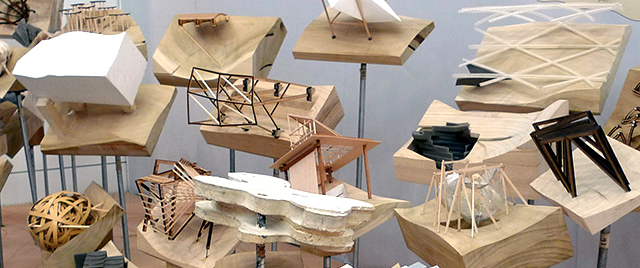

Just as the practice of descriptive geometry has been radically transformed by computational techniques in the past few decades, so this transition into the information age has impacted the domains of manufacturing and fabrication. The dominant paradigm of mass production has begun to be displaced, as artisan practices were before it, and replaced by a much tighter loop connecting design prototypes, design specifications, manufacturing process models, and machine instructions. This paradigm shift in fabrication has folded back upon design - pushing our representations away from the metaphor of drawing, and toward information-based processes that seek higher-levels of authority over architectural design methods.
In this exercise, students both explore parametric modeling and computer-aided manufacturing processes in the context of the construction of a sectional model based upon the "tectonic folly" model designed in 200a. The project focuses on the construction of a manipulated section of ground, 12'x12'x20' in dimension. While only this ground manipulation is required to be constructed parametrically, and fabricated via CNC processes, it also must anticipate the modeling of the remainder of the tectonic folly. The project will pursue two threads simultaneously: a parametric modeling thread, wherein a flexible model of the ground is developed, and a fabrication thread, which entails an exploration of the processes of realizing this model at 1/2" = 1' scale. Models are fabricated by the class such that they fit together into a seamless grid of 12'x12'x20' modules, that collectively describe the topography of Pt Bonita. This collective model forms the centerpiece of an exhibition of work produced by 200c at the end of the semester.
Following the logic of a "solution space" implied by parametric modeling processes, the design for a manipulated ground may occupy nearly any position on the Pt Bonita site, with possible constrains of minimum or maximum slopes. This is realized through the development of a Grasshopper definition. Students define a series of geometric operations that produce a model of your manipulated ground as a single closed poly-surface. This poly-surface forms the basis of cut files required by the CNC fabrication process.
Simultaneous to the development of the parametric model, the class collectively conducts a series of experiments and training sessions in collaboration with Chris Palmer. Following experitmentation in small group, the class collectively decides on the fabrication "style" that is used in the production of the class model (see styles A,B,C, below)
There's more!
Some other projects from this same class have been posted, as well as some interesting student work from this same year.